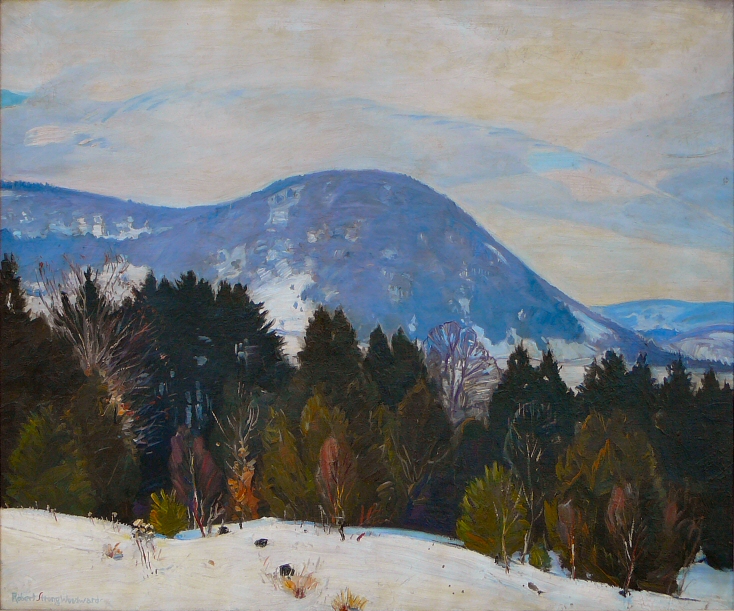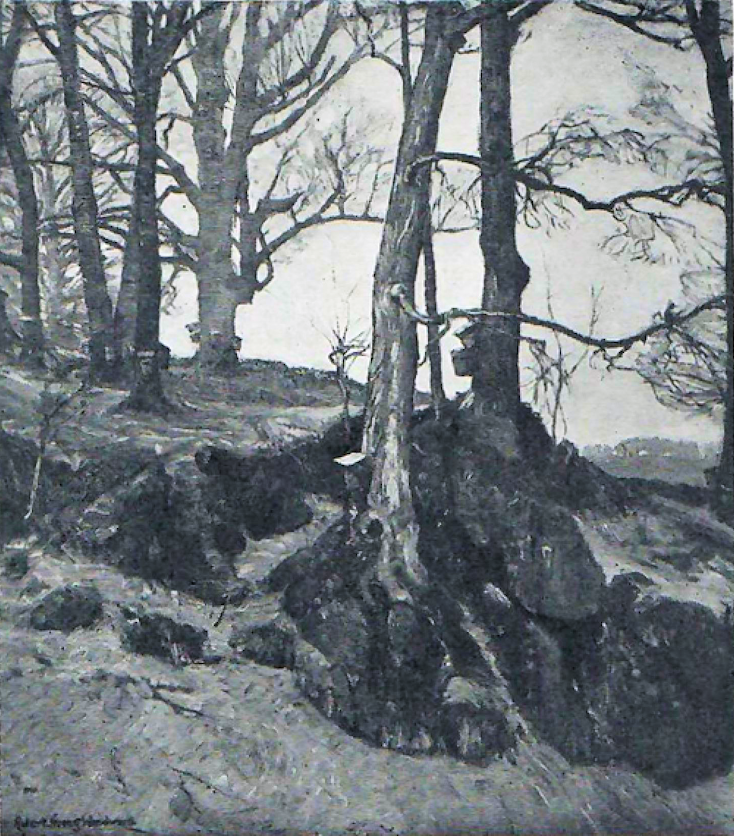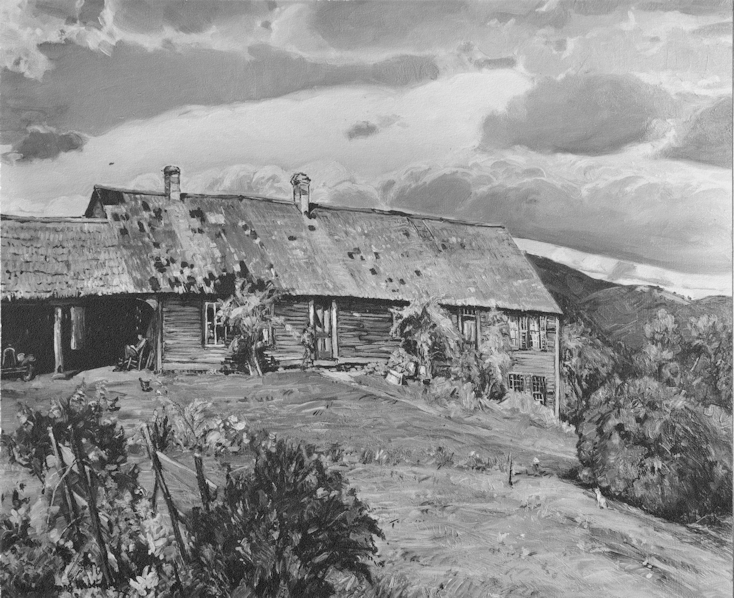Poet Robert Frost
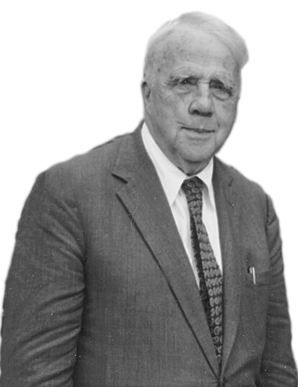
 Poet-Laureate Robert Frost in 1957
Poet-Laureate Robert Frost in 1957
THE IMMEDIATE CONNECTION: Friends from the start
Robert Frost was a close and dear friend of Robert Strong Woodward. The story of their first meeting and the beginning of their friendship comes from Woodward's 1932 personal diary. It is February and the first of 14 exhibits RSW would hold at Amherst College's Jones Library. Frost is teaching at the school and is brought to the exhibition by the Jones Library's director, Charles Green. Green introduces the two. Woodward would proclaim in his diary, "Absolutely delightful visit," adding, "Feel as if old friends. He wants to buy a painting - admiring my work intensely." The very same day, Woodward left 2 paintings at Frost's home for his consideration. It is unknown what paintings RSW left because he would drop two more paintings off at a later date. Then on April 6th, in his diary he reports that he had tea with Frost, and added, "bringing home two of the four paintings he had." Eventually Frost would buy Winter Dignity and it would become one of his wife's most loved paintings.
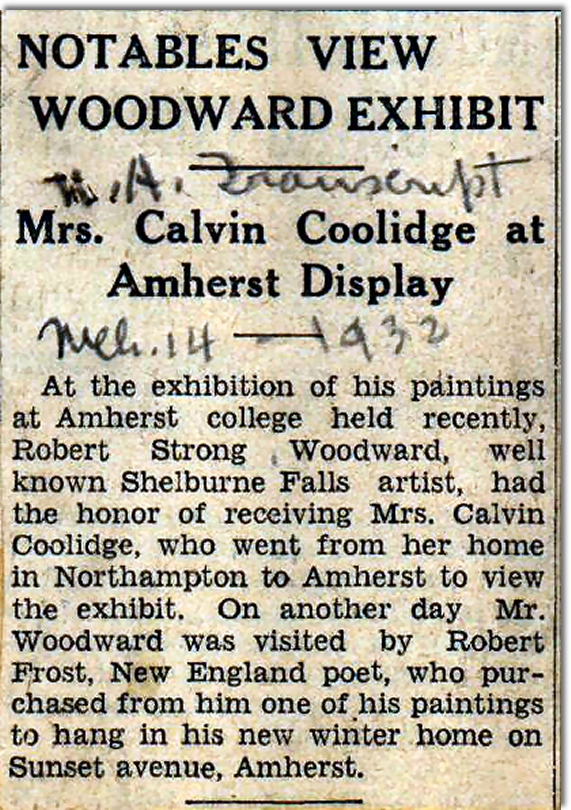
 North Adams Transcript, March 14, 1932
North Adams Transcript, March 14, 1932
In Woodward's tradition he would also leave When Sap Runs with Frost. There is no record or mention of Frost ever buying the painting but it appears Frost had it for a number of years. There is also no additional record in the '32 diary RSW had picked up the third painting! This was not at all uncommon for Woodward. There are a number of examples of Woodward leaving paintings in the care of family, close friends and good customers for extended periods of time. We are not sure if this is a ploy to inevitably sell the painting to its keeper because they would surely not want to part with it when RSW eventually would come to collect it. It is more likely a way of showing his affection to these privileged few. An act of generosity, for which Woodward was well known. Yet, we are left to ask, 'how could he do such a thing when he could continue to exhibit it about and find a different buyer?'
This is pure speculation on our part, still, it is also based on what we know about RSW's habits and tendencies. In our examination of Woodward's catalog and the travels of his paintings, we have noted a number of patterns we believe answers this question. In his early years, the 1920s, he painted a number of Still Lifes that were exhibited but never sold. We suspect they were never sold because they were not for sale. According to our records, not one single still life was ever sold to a customer. Woodward either kept it for himself or gave it as a gift to someone close to him. Coincidentally, 1932, would be the last year he ever paints a "true" Still Life, My Grandmother's Lamp. He would send it to the annual National Academy of Design's Exhibition in NYC, so he was certainly proud of it. He even commented in the dairy it may be his finest still life ever, but he never sold it and it never exhibited elsewhere afterwards.
The 1930s were the height of his prowess and popularity in painting distinctly New England scenes and life. A number of those paintings
were exhibited 'widely" as he would put it. He did exhibit quite a bit in the '30s, more than any other time in his career. Only, a number of those paintings, either never sold or he had them for really long periods of
time before eventually selling them. And still others, sold quickly, but only to museums. Mind you, it was the depression but there is more to it. We believe Woodward painted a series of paintings we call Woodward's
"editorial" pieces, in that, they possessed a distinct brand and signature to his work. Basically, we believe, these editiorial pieces were only for sale to the right customer, such as a museum. A number of these
editorial pieces ended up in museums and shortly after another "editorial" would take its place. There were still others that RSW never sold and kept for himself because he loved them... we believe,
When Sap Runs is one of those paintings. He wanted to keep it for the time being and that is why he could also afford to leave it with a man he greatly admired in Frost. It demonstrates his affection and
respect for poet.
Dr. Mark Purinton (the website's founder and RSW beneficiary), in his original page devoted to Frost commented on this admiration, "...All we have are remnants of Christmas cards
from the famous poet (see below) and the records of the three paintings by RSW which Frost owned during his life. Uncle Rob admired very much his poetry and a number of times during my vacations home from Oberlin College,
we would read aloud selected poems by Frost in front of the studio fireplace. My favorite was 'Stopping by Woods on a Snowy Evening.'" With regard to
When Sap Runs Doc continues, "It is in my memory of driving RSW in the Packard to Amherst College to either deliver or bring back this painting to the studio. It is not known whether Frost actually
purchased this painting or whether it was loaned to him to hang in his apartment, or in the studio where he gave his seminars, when he was teaching at Amherst College. The Woodward diary states that Frost was
extremely fond of this sugaring painting."
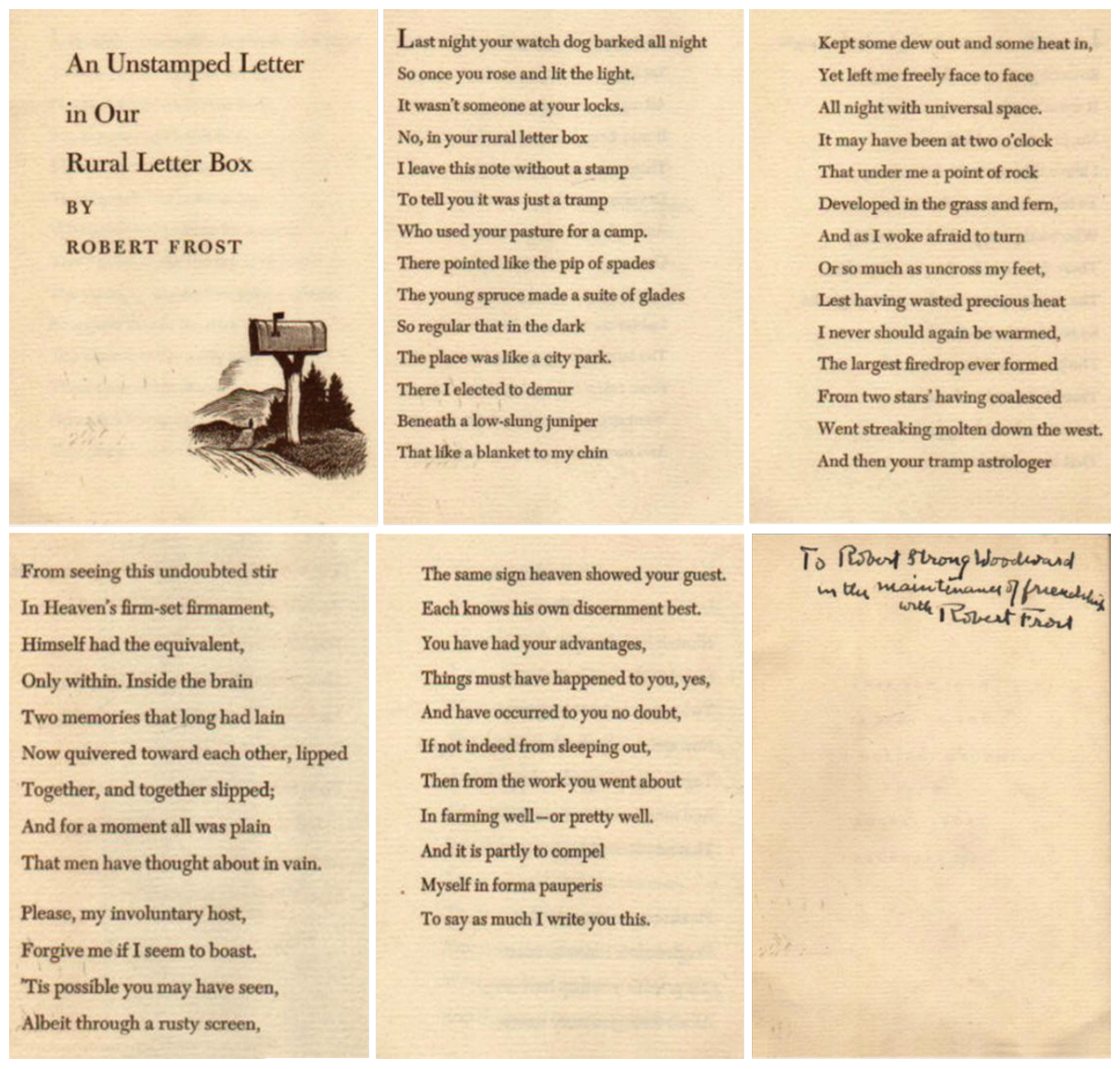
 This illumination (art coupled with words for reproduction in print)
This illumination (art coupled with words for reproduction in print)
An Unstamped Letter in Our Rural Letter Box signed, "To Robert Strong Woodward
in maintenance of friendship with Robert Frost," was sent to RSW at an unknown
date. We do not believe it is in Frost hand but coud be his wife's or an assistant.
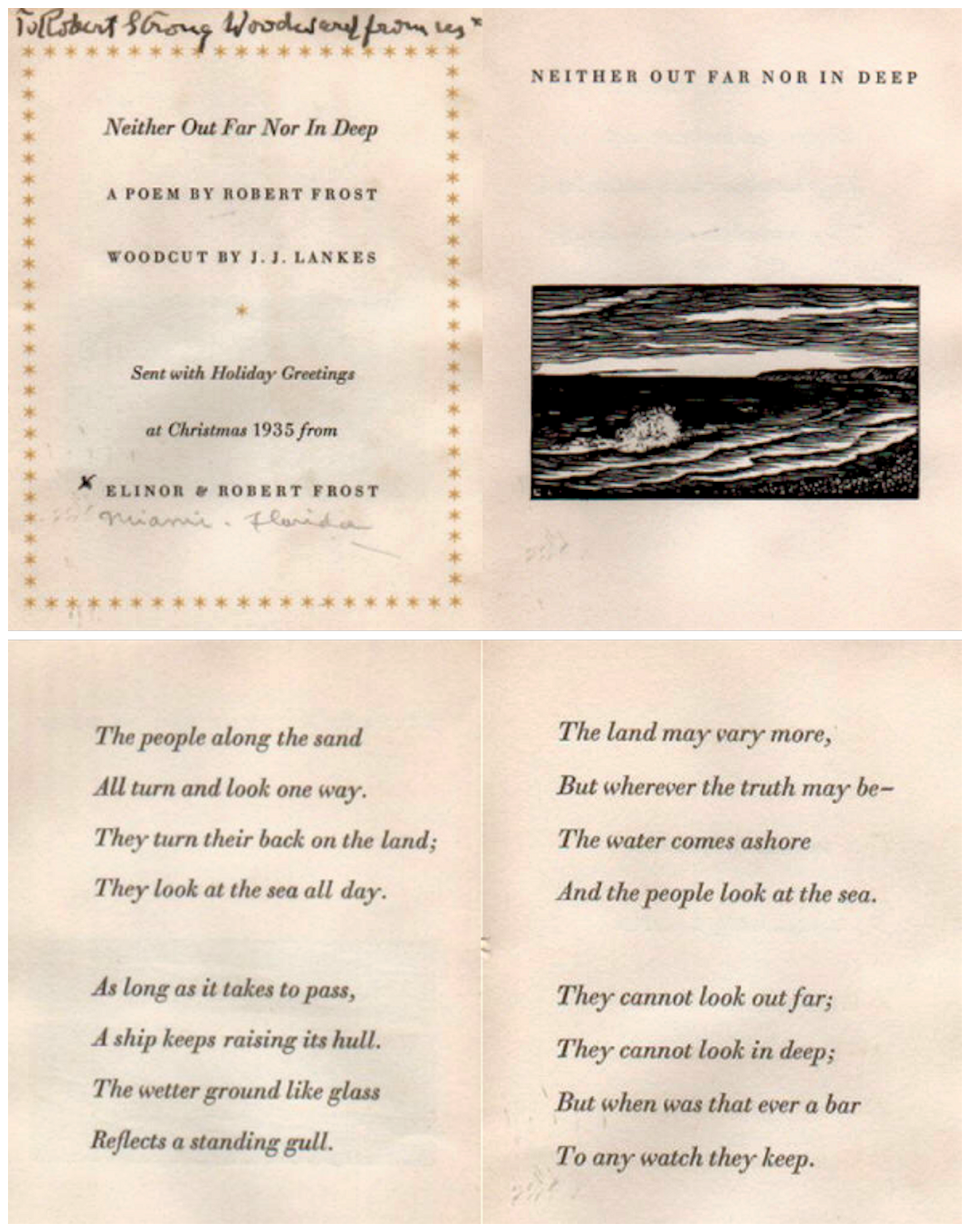
 This illumination (art coupled with words for reproduction
This illumination (art coupled with words for reproduction
in print) Neither Out Far or in Deep was sent to RSW in 1935 by
Frost and his wife Elinor from Miami, FL. These Illuminations
were custom made for their friends during the holidays. Note
the credit for the woodcut of the artwork.
CLICK HERE for Dr. Purinton's Story - Kid on the Street
( Page will open in a new tab)
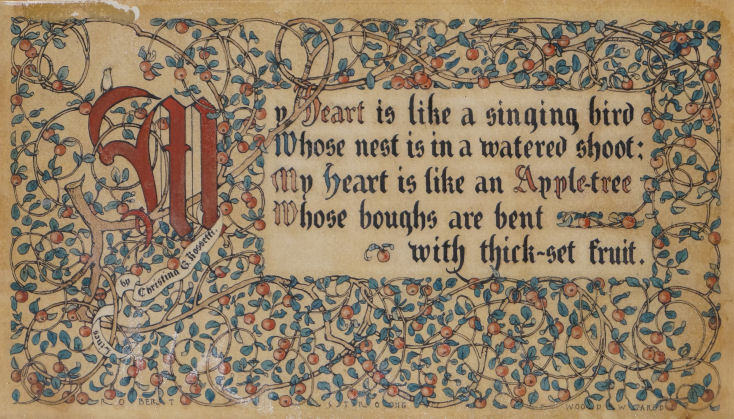
 My Heart is Like a Singing Bird, Illumination
My Heart is Like a Singing Bird, Illumination
THE RELATIONSHIP: It's Complicated
An Editorial by: Brian Charles Miller
I was recently contacted by Nicholas Barron, publisher of the online literary newsletter Bidwell Hollow. He wanted to write an article with regard to Woodward's relationship with Robert Frost. It is part of a series he is doing about the relationship between artist and writers and he wanted
to publish the article in honor of Frost's 136 th birthday. (March 26, 1884 - Please read the article by clicking the link above).
The timing could not be more appropriate. We have just completed transcribing RSW's 1932
personal dairy and I have been compiling material for a future essay on Woodward's interest in poetry and specifically the art of illumination. While putting together the material to supply Mr. Barron, I began to put some deeper
thought to the two men's relationship and it forced me to ask the following question, "Though both mutually admired each others work, why where they not closer? This essay hopes to explore this very question with the hope it will add a
greater context into Woodward's first career as a commercial artist.
 Undated Oracle Article regarding the
Undated Oracle Article regarding the
purchase of Winter Dignity by Frost. For
an easier read CLICK HERE for a
complete transcription in PDF form.

 Undated Oracle Article
Undated Oracle Article
The two men shared a great deal of common ground and experiences. Both, one could say, had their share of tragedy befall them. Woodward, at the time of his first introduction to Frost; was paralyzed from the chest down from an accident with a revolver at age 21 and a studio fire in 1922 nearly cost him his career and Frost; would loose both his parents and sister before their meeting in 1932, his father when he was just eleven years old. Coincidentally, RSW would loose his older brother Ory when he was eleven as well. They would also share an experience living on both coast of the country - RSW in Los Angeles, CA and Frost was born in San Francisco and lived there to the age of 11. Despite the subject they are known for, the rural life, both grew up in cities! They also shared a tumultuous path in regard to their education - RSW attended as many as 9 different schools in an eleven year period growing up and left the Museum of Fine Arts School, Boston, after just two months due to illness and other difficulties. Frost would leave Dartmouth after just two months to help his mother. Later he finish his degree at St. Lawrence (NY) University but then would leave his graduate studies at Harvard later due to illness. Finally, both were seen as ambassadors in the region of New England and had considerable recognition; Frost won his second Pulitzer Prize for Poetry in 1931 (the first in 1924) and Woodward; would win the First Prize in Hallgarten Category for best artist at the National Academy's 1919 Annual Exhibition and honored with a one of just four Gold Metal Awards at the 1930 Boston Tercentennial Celebration. Both men would also frequent and travel the same landscapes of Southeastern Vermont and at one time live in the Hudson River area (Frost - in Lawrence, and RSW in Schenectady). The similarities are quite remarkable when you spell them all out. What is also important to note is Woodward's fondness for academic types, particularly teachers/professors. Many of his closest friends who regularly visited and picnic'd with RSW were teachers/professors at various colleges and schools in the surrounding area.

 Above: The Hiram Woodward Home
Above: The Hiram Woodward Home
& Studio, his home when he met Frost and
Below: The Southwick Home & Studio
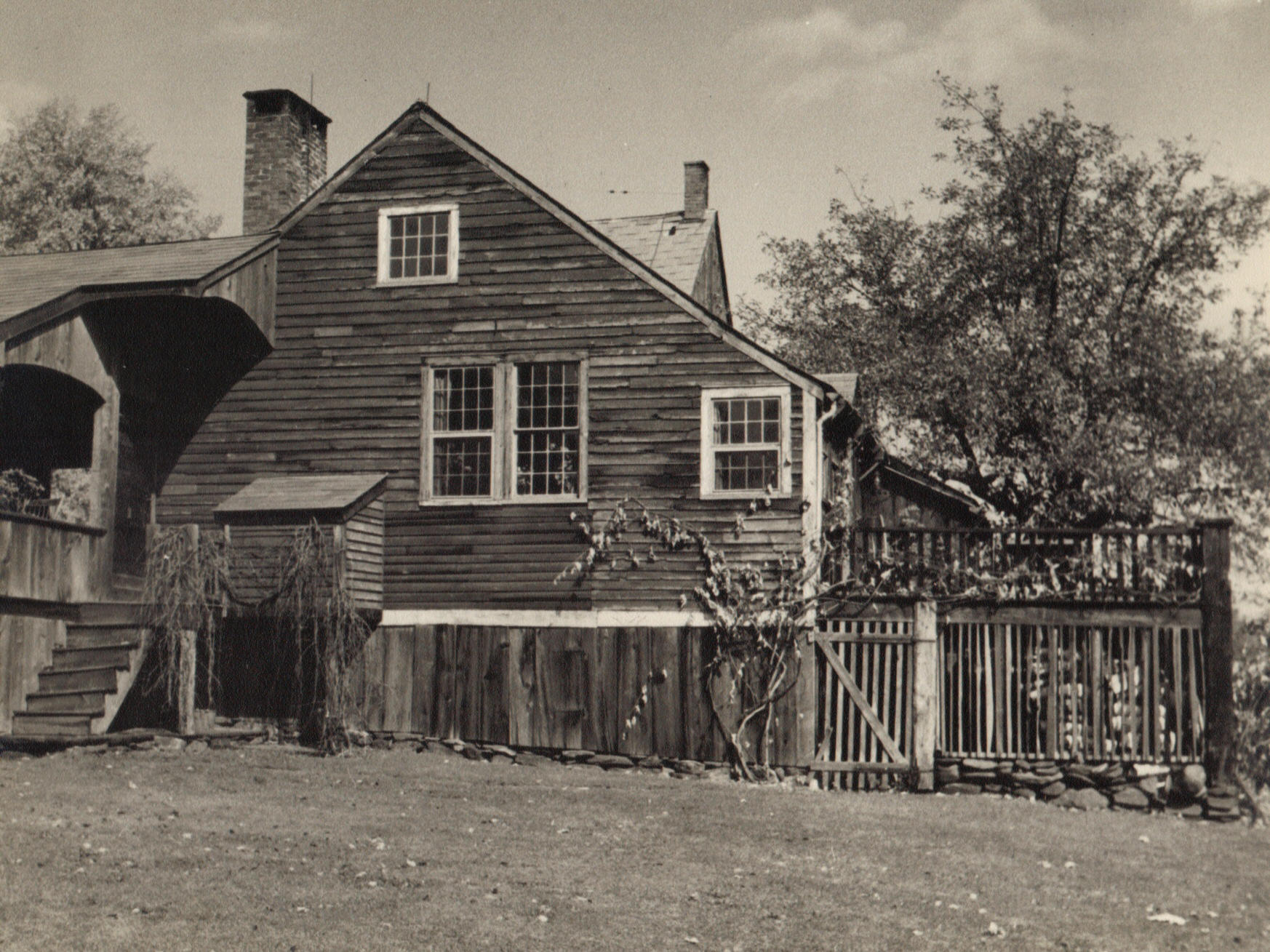
To answer the question raised above, let's first state the obvious... Frost was a busy man in high demand. Not only was he happily married, with children, he is teaching - a very time consuming profession. And he was teaching year round, spending his summers at Middlebury College's Bread Loaf School of English. Frost also had multiple homes in different states (Michigan, Vermont, Massachusetts, Florida) and kept an apartment in Boston. In 1935, Frost and his wife began wintering in Miami, at his Pencil Pines estate. Frost quite simply is all over the place. Woodward on the other hand, with the exception of about 3 to 4 and once a year trips to Boston and NYC respectively, stays within an hour of his home. Woodward's Folly ( The Little Shop), his retreat (The Heath Pasture and his homes (The Hiram and Southwick Places) are all within 30 minutes of each other. And I have to admit, I do not know how Woodward would feel about "wintering" anywhere else other than where winter happened but it is a safe guess it would not be Florida. Frost, even with all of the other demands of his life, still had to find time to write and work, whereas, Woodward was, for the most part solitary and alone (not including his nurses and attendents who cared for him) and for all intents and purposes had only his work to occupy himself.
CLICK HERE for more on Woodward's Studios
( Page will open in a new tab)
THEIR CAREERS: Divergent Trends and Acceptance
The truth is Frost is a superstar by comparison. The poet was nominated 31 times for the Nobel Prize in literature and would never win the but collect two more Pulitzer's (1937, 1943) matching Eugene O'Neill's record (O'Neill did however win the Nobel in 1936). Frost would receive the Congressional Medal of Honor (1960), and be officially honored, "Poet laureate of Vermont" by its state legislature (1961) and unofficially considered by many to be the nation's poet laureate. Woodward on the other hand, according to Alistar Maitland's commentary in his essay on RSW for the THE BOOK OF HEATH BICENTENNIAL ESSAYS, in 1985 writes, "that Woodward, whose immense talent, despite all the odds, achieved wide recognition and brought him a measure of material success during his lifetime, should not be better known today. It can hardly be said that his name is a household word, even in Heath, or Buckland."
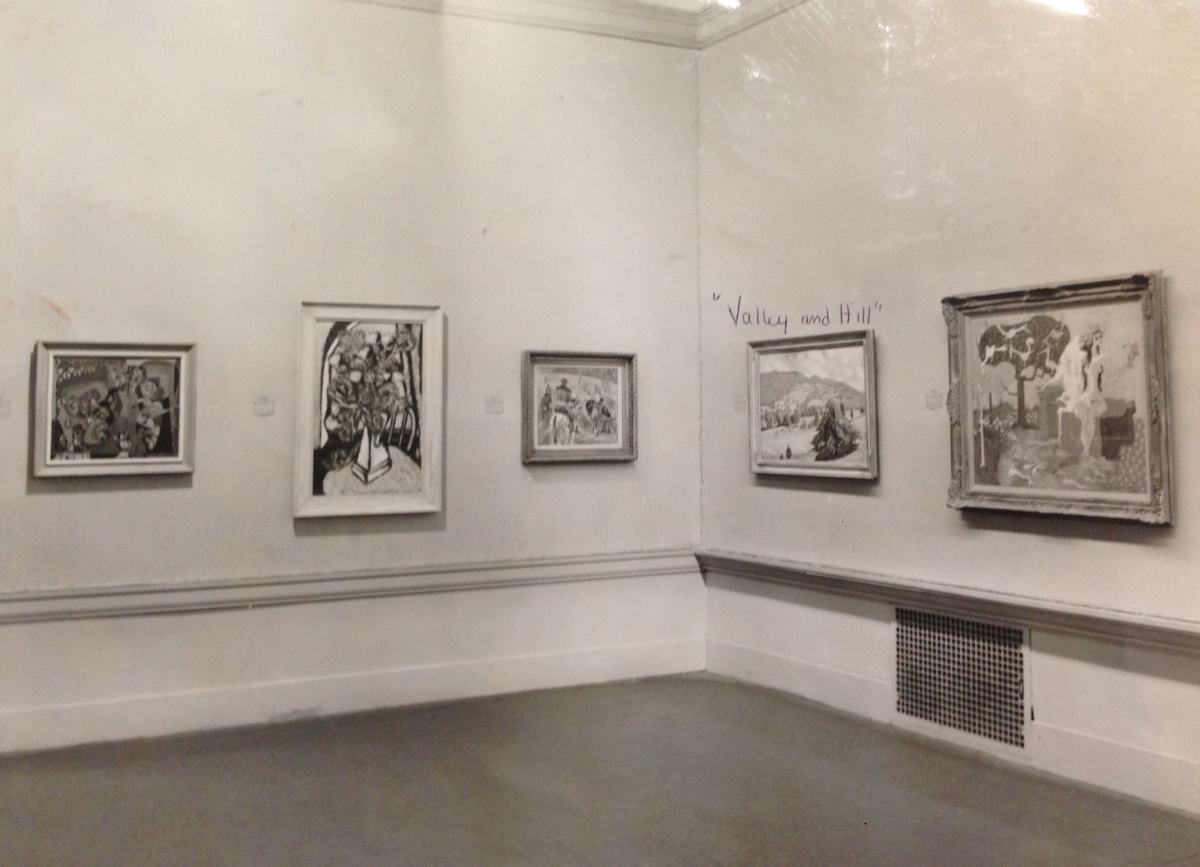
 An image of the 1945 Carnegie Institute
An image of the 1945 Carnegie Institute
Exhibit illustrates what Woodward is up against.
Here Valley and Hill, is shown hanging among
four clearly modern abstractions.
Unfortunately this comparison is also not entirely fair. While in the publishing world, Frost's traditionally colloquial sentiments, like Twain, O'Neill and Steinbeck, are more wildly accepted and even sought out where Woodward is facing a completely different marketplace. First of all, as a Naturalist landscape artist, RSW is one of just a small niche of painters. Secondly, the trend toward the more fantastical and abstract visions of impressionism, cubism and surrealism is dominating the art world. Not even social realism is real but an exaggerated version of what is real. Woodward's real-life portrayals of nature in natural light, without embellishment or any personal interpretation simply does not grab the attention of the popular audience of his time. Frost has a number of contemporaries he can be linked to, Frost is not competing against science fiction (which would not gain popularity for a couple of decades), nor is he being overwhelmed by the modern escapism of fantasy or innovation. In fact, Frost is considered quite traditional and not the innovator then, let's say, a Walt Whitman. Whereas Woodward sort of stands out and appears un-imaginative by comparison. Also, and worth noting, is that portrait artist and still life artist are still wildly popular.
There are three examples to illustrate my point. One is the image of the 1945 Carnegie Institutes Annal Exhibition seen to the left. At the 1930 Boston Tercentennial Celebration the three other artist to all receive gold medals were all awarded for their portrait paintings. At the famed Corcoran Biennial Exhibit of 1941, Woodward took 3rd prize in the popular vote for August Shade. He was just two votes shy of second place. The first two prizes were also portrait paintings. So basically, Woodward was the top finishing landscape artist in both exhibitions, right? As far as still lifes are concerned, RSW made a deliberate decision to not make a name, though he could have. It is possible that he felt still lifes and his disability were a bit too spot-on. It is also possible Woodward's aesthetic found still life's too unnatural for his liking, after all they are almost exclusively "staged" and therefore pretense. Window Paintings were Woodward's take on the still life and his most popular paintings.
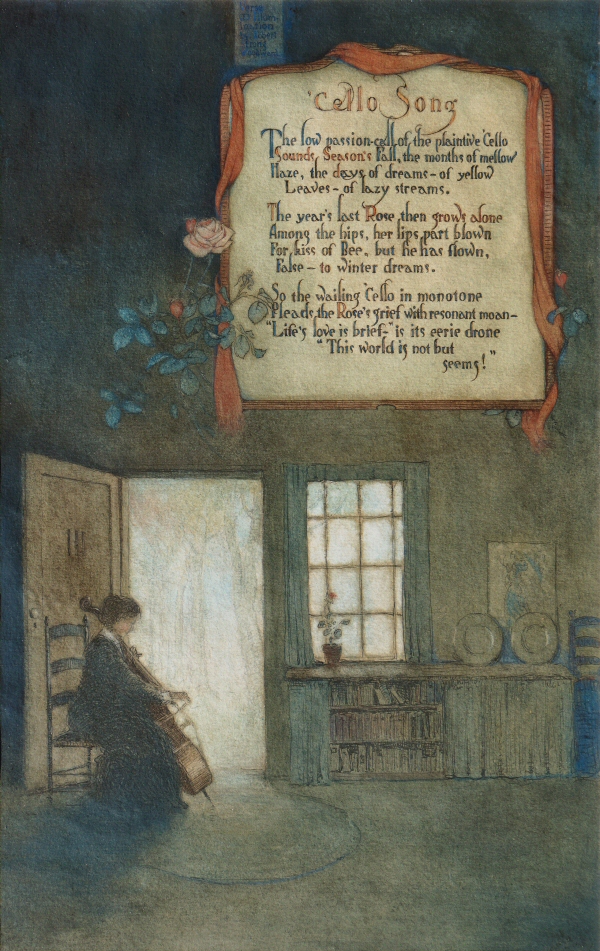
 The Cello Song, Illumination
The Cello Song, Illumination
What is often overlooked about Woodward's career is he was essentially first a commercial artist before becoming a landscapist. This is important because it would be another item that could conceivably draw the two men together. In some cases, Woodward wrote his own poetry to accompany his artwork (see The Cello Song Illumination to the right). While Woodward was primarily earning his way making heraldic devices, such as, Bookplates for some of the nation's wealthiest men, along with illustrations for print; he aspired to make a product of his own original work with regard to Illuminations. At their most basic, illuminations are simply - poetry or verse lettered with calligraphy and complimented by artwork fitting the verse. They are meant to be inspirational. The tradition of illuminations have a steep history in both western culture, as well as, the east. Arguably it is more commonplace and popular in the east. The pamphlet-like cards Frost made annually for close friends are essentially, illuminations. Particularly he one that includes the woodcut block art. Woodblock carvings are traditionally associated with the illumination. The greeting card industry literally stands on the shoulders of the illumination tradition.
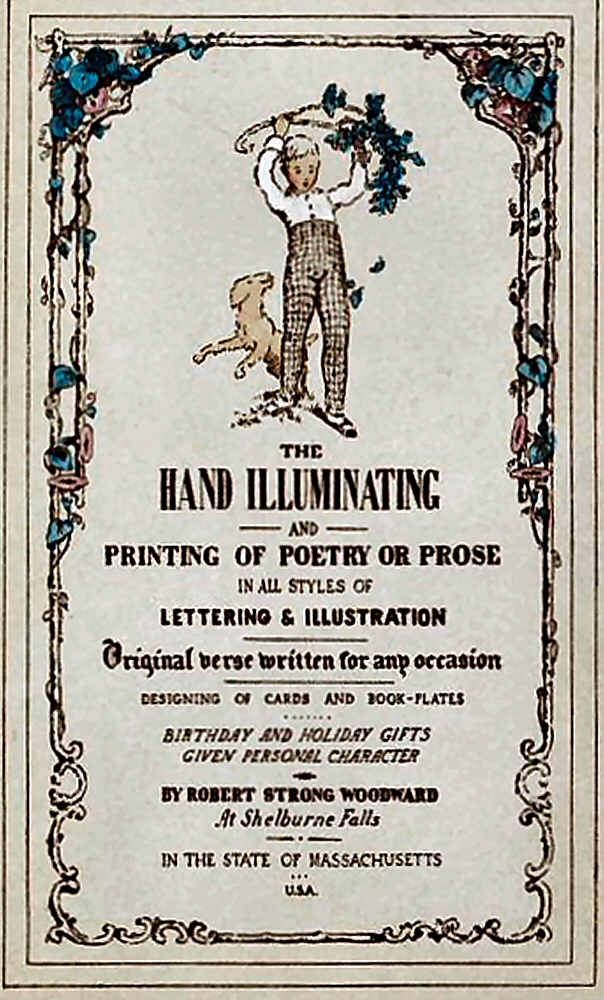
 Woodward's Business Card, 1911 - 1916
Woodward's Business Card, 1911 - 1916
Since his death and particularly since 1970 with the compilation of his
catalogue by the Deerfield Academy's American Studies Group the narrative that RSW had always aspired to become a landscape artist has been generally accepted. Woodward himself started the story telling
reporters and friends as much. However, prior to his arrival in Buckland (1910) and the year and he actually began to paint (1917), there is little to no evidence to support it. In fact the evidence strongly suggest
Woodward's first love and what he was preparing himself to do prior to and even after his accident was to be a commercial artist.
Woodward, in a 1906 letter to childhood friend Helen Ives Schermerhorn,
writes, "It would be so delightful to have something to say to the world, something of vital life interest, and to be able to say it as one should - to be a Carlyle, MaCauley, a Voltaire, or Ibsen, and - by all means a Browning.
But during such wishes I catch myself and say, knowing within me the while, that it's to be quite as beautiful to be an artist, to tell men of godly beauty thru color and form, my religion, especially the former. But, chere
Helene, how completely ultra, at the supreme point, would it, be to be able to do both? I do not see why such a man could not occur." I will not make my argument in this essay. It is for a future essay to make my case.
Still, I will say that most all of the artwork was have knowledge of prior to 1910 is almost entirely gifts of cards and illuminations to family and friends. There are only two known oil paintings (1896 and 1908). The very
first thing he made after his accident was a "self-published" illumination booklet, The Love Leaf, using calligraphy of verse from Robert Browning's
poem Pauline accompanied by a couple of his ink wash (a popular art
form in Japanese illuminations) drawings. In another letter to Helen, he tells her of his studio in Los Angeles still is not complete and goes on to inform her of some print work he is working on for a friend and then ask
Helen, what sort of bookplate she would like? The evidence Woodward desired to make a career in the field of commercial art is considerable.
The assumption that Woodward's first career as a commercial
artist was a stop-gap measure after leaving the Museum of Fine Art School in Boston could be wrong. His love for poetry ("poetic" was widely attributed to him as a painter by many critics) and the desire to inspire using
both art and the written word, especially after his accident, would not be what fate would have in mind for Woodward. And I wonder if this was an inner wound for the man. Was this something that put a distance between
RSW and Frost - an envy of sorts? That made their being closer friends difficult for RSW? Envy is such a complex element in any relationship. It forms more than its share of rivalries but it can often present itself in mutually
respectful relationships. I can really love and admire a friend or colleague for their remarkable work and still struggle inwardly if they are more successful and recognized than me. It is an awful feeling that then piques even
greater shame for the resentment I feel towards the person. It is a question worth asking in regard to RSW's relationship with Frost. Was it just simply more difficult for Woodward to be Frost's friend, to be in the same room
as the man, than the other way around?
Even though Woodward is having a successful career as a landscape artist. It pales in comparsion to Frost whose path is seemingly so much easier and acclaimed for
expounding what is essentially very similar sentiments on rural life to RSW.
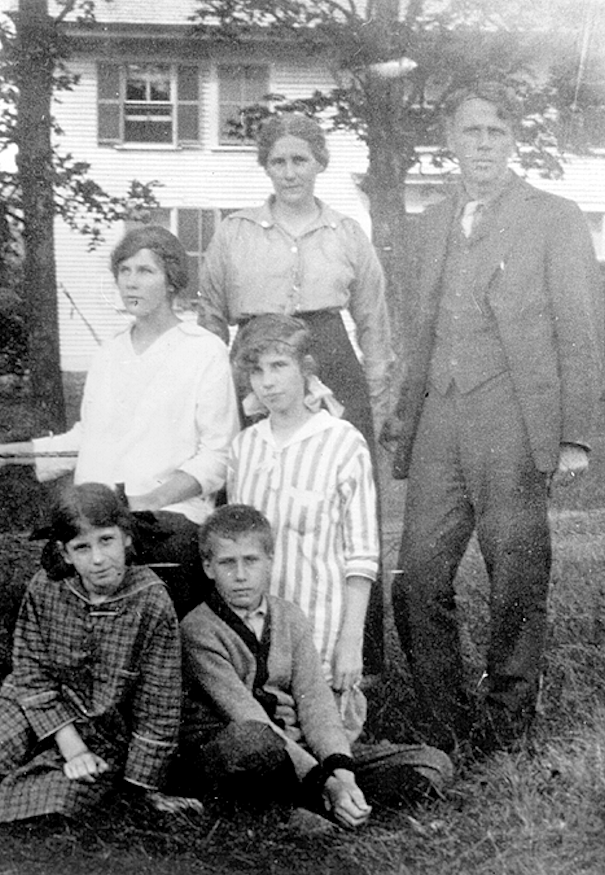
 Frost and his wife Elinor with their children
Frost and his wife Elinor with their children
A PERSONALITY CLASH: The Same but Different...
Another invisible quality that affects a relationship between people is the dynamic of personality. Woodward especially liked people who share
the same interest but even more so - people who appear to be "cut from the same cloth" as Woodward. RSW was a rugged, vigorous, "hirsute pipe smoking cuss that knows real work," and in his own words, "no languishing
lily." Woodward's struggle was by no means a life of comfort. He preferred it that way, chose it in fact. Yet, there were also aspects of his life, particularly the result of his condition, that made him susceptible to illnesses and
he lived with constant, real, and chronic pain throughout his life. There are numerous entries in his 1932 diary where he reportedly felt, "wretched." There are days he finds it difficult to even get out of bed. Dr.
Purinton has told me on more than one occasion he recalls Woodward going through bouts of depression lasting a few days at a time. He describes Woodward sitting at his desk in the Southwick Studio with his head in his
hands staring down at his pad. This is understandable considering his condition, still, these moments are brief and fleeting.
Frost on the other hand, reportedly struggled with depression throughout his life. Depression was in
fact, quite common in his family. Depression is a serious condition and I do not wish to make light of it by any means. It is often misunderstood for being a pathetic condition or a means for getting attention and wallowing in
self pity, and even believed to be a personal choice to be brooding and complex. By today's standards we understand it is a serious condition and still, fall victim to our default reactions to one suffering from it. In the 1930s it
is simply not seen the same way. It would be seen as a weakness. Something Woodward would have surely found contemptible. For everything RSW goes through just to get out of bed... he gets out of bed because he loves
and cherishes life. What if, in any way, Frost came across as a bit of a sad-sack during their time of getting to know each other? How do you think Woodward would feel about that?
The evidence to suggest the distance Woodward felt in his relationship with Frost just may be best illustrated in the events
leading up to and following Frost request he swap Winter Diginity for another of RSW's paintings. Frost's wife Elinor has passed. He hasn't return to
his regular home in Amherst and has now moved to Cambridge, MA. He is still in possession of When Sap Runs and has Dr. Purinton, then just simply
Mark, retrieve the painting. In Woodward's own words he writes in his painting diary regarding, Winter Dignity, the following, "Robert Frost, to my amazement, wrote me that since his wife had been so fond of this
painting, for sentimental reasons he felt I would understand (though I somewhat failed to do so) he would like to know if he could exchange Winter Dignity for another canvas of mine." Woodward is clearly irked
but note the lack of compassion in his tone... how he does not understand. This is the 1940s. Woodward and Frost have been friends for nearly 8 years now but the distance between the two seems obvious here. I was quoted
in Nicholas Barron's article that in regard to RSW coming along to deliver paintings to an interested customer, "I only have a handful of examples where Woodward himself went to such trouble. He usually delegated this task
to people working for him. So he is showing Frost deference." The deference, however, by the 1940s is clearly diminished. First, he took back what may have very well been an unspoken gift to Frost by sending Mark alone to
collect When Sap Runs from Amherst. He then deligates someone else working for him (not Mark) to deliver three paintings to his Boston dealer, the Vose Galleries, for Frost to choose just one.
The fact
RSW had a third party, in Vose, handle the transaction suggest Woodward has distanced himself from Frost. To not even bring the paintings to Frost's apartment in Cambridge speaks volumes as to the state of the relationship.
Still, he does show Frost some warranted respect by sending at least one other "editorial" painting, Passing New England. Frost rightly chooses this
painting which was personally invited to the 1937 Chicago Institute of Arts' Annual Exhibition by its curator Robert Harshe. The painting is one of the last of RSW's pinnacle decade of uniquely New England portraits.
It does surprise me how privately insensitive RSW appears to be toward Frost. Yet, consider the following - Woodward had not been to this date nor ever would he marry. He could hardly relate to the powerful emotions of such a
loss. Still, Woodward really valued (and it was very much a part of his ability to persevere), putting the past behind him and moving forward. You would think, this at least, RSW would understand. It is, in essence, what Frost
is doing while maintaining his mutual regard for the artist to have a piece of RSW's work in his collection. Frost could have simply stuffed Winter Dignity in a closet or given it away to some friend or one of his children.
This is also the reason I believe the two, while admiring the other's work so much, did not connect on the levels that really counted towards a close relationship forming. They may have been, just simply, not each others cup of tea. As
a footnote to all of this... it has always been rumored that Woodward hosted Frost to one of his famed studio dinner parties. We suggest as much in a number of pages on this website, only we have no actual proof or confirmation
of such an event ever happening and question if it did? I am sure at the very least, Woodward would want such a distinguished guest to dinner but no longer would I be surprised to learn it never happened. BCM

